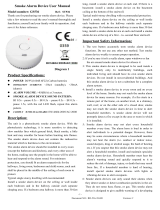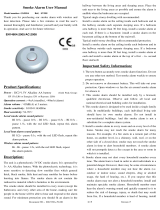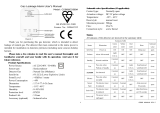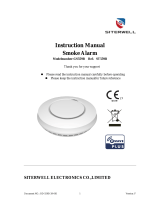Page is loading ...

Document NO.: RD-529-39-001 Version: A
- 1 -
EN14604:2005/AC: 2008
Smoke Alarm User Manual
Model number: GS529 Ref:ST529
Thank you for purchasing our smoke alarm with wireless and
heat detection. Please take a few minutes to read the user’s
manual thoroughly and familiarize yourself and your family
with its operation. And save it for future reference.
Diagram 1
Product Specifications:
Power :built-in DC3V(CR17450) Lithium battery (battery
can be replaced.)
Operation current : ≤90mA
Alarm volume : ≥85dB(A) at 3 meters.
Smokesensitivity :0.09-0.15dB/m
Local smoke alarm sound pattern:
BI 0.5s - pause 0.5s – BI 0.5s – pause 0.5s – BI 0.5s –
pause 1.5s- BI 0.5s - pause 0.5s – BI 0.5s – pause 0.5s
– BI 0.5s – pause 4.5s, with the red LED flashing
every 1 second, repeat this alarm pattern.
.
Wireless alarm pattern:
Bi 0.2s - pause 0.1s - Bi 0.2s - pause 1.2s, with the
red LED flashing every 1.0 second, repeat this alarm
pattern.
Description:
This unit is a photoelectric 3V DC smoke alarm. It is
operated by DC 3V(CR17450) lithium battery. With the
photoelectric technology, it is more sensitive in detecting
slow smoldering
fires which generate light smoke, little heat and may smolder
for hours before bursting into flames. This smoke alarm does
not contain any radioactive material. Smoke alarms should be
installed in every room (except the bathroom and kitchen),
finished attics and basements, making sure the people in the
home will be able to hear and respond to the alarm sound.
For minimum protection, you should install an alarm on
every level of the home particularly outside sleeping rooms.
Each alarm should be placed in the middle of the ceiling of
each room to be protected. Typical single storey dwelling
installation recommendations: Install a smoke alarm on the
ceiling inside each bedroom and in the hallway outside each
separate sleeping area. If a bedroom area hallway is more
than 30 feet long, install a smoke alarm at each end. If there
is a basement: install a smoke alarm on the basement ceiling
at the bottom of the stairwell. Typical multi-storey dwelling
installation recommendations: Install a minimum of one
smoke alarm on each occupiable level of the home. Install a
smoke alarm on the ceiling or wall inside each bedroom and
in the hallway outside each separate sleeping area. If a
bedroom area hallway is more than 30 feet long, install a
smoke alarm at each end install a smoke alarm at the top of a
first – to- second floor stairwell.
Important Safety Information:
1:The test button accurately tests smoke alarm functions. Do
not use any other test method. Test smoke alarm weekly to
ensure proper operation.
2:If you're sure it isn't a really alarm, open windows or fan
the air around smoke alarm to reset and silence it.
3:User to install this product needs to comply with all local
and national electrical installation and building codes.
4:This smoke alarm is designed to be used inside a single
family home only. In multifamily buildings, each individual
living unit should have its own smoke alarms. Do not
install in non-residential buildings as this smoke alarm is
not a substitute for a complete alarm system.
5:Install a smoke alarm in every room and on every level of
the home. Smoke may not reach the smoke alarm for many
reasons. For example, if a fire starts in a remote part of the
home, on another level, in a chimney, wall, roof, or on the
other side of a closed door, smoke may not reach the smoke
alarm in time to alert household members. A smoke alarm
will not promptly detect a fire except in the area or room in
which it is installed.
6:Smoke alarm may not alert every household member every
time. The alarm horn is loud in order to alert individuals to

Document NO.: RD-529-39-001 Version: A
- 2 -
a potential danger. However, there may be some
circumstances where a household member may not hear the
alarm (i.e. outdoor or indoor noise, sound sleepers, drug or
alcohol usage, the hard of hearing, etc.). If you suspect that
this smoke alarm may not alert a household member, install
and maintain specialty smoke alarms. Household member
must hear the alarm’s warning sound and quickly respond
to it to reduce the risk of injury, or death that may result
from fire, if a household member is hard of hearing, install
special smoke alarms with lights or vibrating devices to
alert occupants.
7:Smoke alarms can only sound their alarms when they
detect smoke or detect combustion particles in the air. They
do not sense flame or gas. This smoke alarm is designed to
give audible warning of a developing fire. However, many
fires are fast - burning, explosive, or intentional, and others
are caused by carelessness or safety hazards. In such
circumstances, Smoke may not reach the alarm QUICKLY
ENOUGH to ensure safe escape. Therefore the installation
of smoke alarms is not a substitute for practicing fire safety
in the home.
8:Smoke alarms have limitations. This smoke alarm is not
foolproof and is not warranted to protect lives or property
from fire. Smoke alarms are not a substitute for insurance.
Homeowners and renters should have adequate insure to
protect their lives and property. In addition, it is possible for
the smoke alarm to fail at any time. For this reason, you
must test the smoke alarm weekly and replace them every 5
years.
Do Not Install Smoke Alarms in
the Following Places:
1: Near appliances or areas where normal combustion
Regularly occurs (kitchens, near furnaces, hot water
heaters). Use specialized smoke alarm device with
unwanted alarm control for this areas.
2: In areas with high humidity, like bathrooms or areas near
dishwashers or washing machines. Install al least 10feet
away from these areas.
3: Near air returns or heating and cooling supply vents.
Install at least 3 feet away from these areas. The air could
blow smoke away from the detector, interrupting its
alarm.
4: In rooms where temperatures may fall below 0℃ or rise
above 40℃, or in humidity higher than 93%. These
conditions will reduce battery life or cause a fault alarm.
5: In extremely dusty, dirty, or insect – infested areas
influence particles interfere with smoke alarm device
operation.
Battery Specification:
Rating voltage: DC 3V
Package: lithium battery
Recommend battery:
EVE : CR17450
Replace Battery:
1:Turn the alarm body counterclockwise and take out the
alarm body from the bracket.
2:Take out the old battery from the battery box.
3:Fix the new batteries to the battery box. Please note the
battery polarity. Reverse can lead to battery life
4: Fit alarm body on bracket and turn the alarm body
clockwise.
5: Test smoke alarm using test button. The sound pattern is 3
short and weak beeps, 1.5seconds pause, 3 short and week
beeps, 4.5seconds pause, repeat it, If continue testing , the
beeps will become louder. If there’s no sound output, it
means that the smoke alarm is faulty or the installing
operation is wrong, and you should gain the correctly
method of disposal through reading “TROUBLE
SHOOTING”.
NOTE: During testing, because the unit send the wireless
signal, the other smoke detector will alarm. Once release
the test button, the other smoke detector will stop alarming
in one minute.
Operation:
Testing
Test the unit weekly to ensure proper operation by pressing
the test button. This will sound the alarm if the electronic
circuitry, horn, and battery are working properly. If no alarm
sounds, the battery may be depleted or another problem, refer
to “Trouble shooting” section for a solution.
DO NOT use an open flame to test your alarm, you could
damage the alarm or ignite combustible materials and start a
structure fire.
CAUTION: Always stand an arms-length away from the unit
when testing. Test the alarm weekly to ensure proper
operation. Erratic or low sound coming from your alarm may
indicate a defective alarm. Refer to “Trouble shooting”
section for a solution.

Document NO.: RD-529-39-001 Version: A
- 3 -
NOTE: WEEKLY TESTING IS REQUIRED
LED indicators
This smoke alarm is equipped with red LED indicators.
Standby Condition: The red LED will flash every 50
seconds to indicate that the smoke alarm is operating
properly.
Alarm Condition: When the alarm detects products of
combustion and goes into alarm, the red LED will flash
rapidly (one flash per second). The rapid flashing LED and
pulsating alarm will continue until the air is cleared or the
test button is released.
Silence Condition: The red LED will flash every 16 seconds
as long as the alarm is in Hush mode.
Low battery trouble indication: An intermittent “chirp”
accompanied by a red LED flashing every 50 seconds
indicates a low battery, you may press the test button to
silence the trouble indication for 10 hours, but it will reset
automatically after 10 hours. During this condition the unit
will continue to operate normally and detect smoke and
sound an alarm. This action only temporarily silences the
chirp.
As the battery in this unit is replaceable. When Replace
the batteries. Make sure to use EVE CR17450 and install
them in the right order.
Fault indication: This chirp will occur between the flash of
the red LED indicator light.
NOTE: When the unit chirps once every 50 seconds,
pressing the test button temporarily silences this warning
tone for 10 hours,Refer to “Trouble shooting” section for
solutions, if the fault signal reactivates, you MUST replace
the unit with a new alarm at once or contact you retailer
during warranty.
SMOKE SENSING CHAMBER OPERATION: The alarm
will “chirp” if any of the components in the smoke sensing
chamber fail. This chirp will occur between the flashes of the
red LED indicator light. (If the chirp occurs at the same time
as the red LED flashing, indicating a low battery
information).
Alarm silence (silence mode):
When the alarm sounds check for a fire first, After verifying
that it is not a fire the alarm can be silenced by pushing the
test button This will silence the alarm for approx 10 minutes.
The red LED will flash once every 16 seconds indicating the
smoke alarm is in the silence mode. Smoke alarms are
designed to minimize nuisance alarms, but combustion
particles from cooking may set off the alarm if the alarm is
located close to the cooking area. To minimize the
occurrence of false alarms, smoke alarms must be installed a
minimum of 10 feet(3 meters) from the nearest cooking
appliance. If you accidentally let some smoke into the alarm
cause alarm, you can open the doors and windows. Turn on
the fan blew it. The alarm will silence (test button) is
extremely useful in a kitchen area or other areas prone to
nuisance alarms. The silence feature is to be used only when
a known alarm condition, such as smoke from cooking
activates the alarm. The smoke alarm is desensitized by push
the alarm silence (silence mode) on the smoke alarm cover,
the alarm will silence to indicate that the alarm is in a
temporarily desensitized condition. The smoke alarm will
automatically reset after approximately 10 minutes, if after
this period, particles of combustion are still present, the
alarm will sound again. The alarm silencer (silence mode)
can be repeatedly until the air has been cleared of the
condition causing the alarm.
CAUTION: Before using the alarm silence (silence),
identify the source of the smoke and be certain a safe
condition exists.
DANGER: If the alarm sounds, and it is not being tested, it
means the unit is sensing smoke, THE SOUND OF THE
ALARM REQUIRES YOUR IMMEDIATE ATTENTION AND
ACTION.

Document NO.: RD-529-39-001 Version: A
- 4 -
Maintenance and Cleaning:
In addition to weekly testing, the alarm requires periodic
cleaning to remove dust, dirt, and debris. Clean the alarm at
least once a year to remove dust, dirt, or debris. Use a
vacuum cleaner with a soft brush, vacuum all sides and
covers of smoke alarm. This alarm has a low battery monitor
which will cause the alarm to “chirp” approx every 50
seconds and the red LED flashes once at the same time for a
minimum of 7 days when the battery gets low. If there is a
defective battery or other failures, you can refer to “Trouble
shooting” for solution, if there are still failures during
warranty, you can return to your retailer.
IMPORTANT: Do not attempt to remove the cover to clean
inside. This will void the warranty.
Repair:
Caution: Do not attempt to repair the alarm. It will affect
your warranty.
If the alarm is not operating properly, and is still under
warranty, return it to the original place you buy. Pack it in a
well-padded carton, and ship to the original place you buy.
If the alarm is no longer under warranty, have a licensed
electrician replace it immediately with a comparable alarm.
Trouble shooting:
DO NOT disconnect battery to quiet an unwanted alarm. This
will remove your protection. Fan the air or open a window to
remove smoke or dust.
Problem
Cause and Remedy
Smoke alarm does not
sound when tested.
1.Clean smoke alarm. Please refer to
the “maintenance and cleaning”
section.
2.If problems persist and the unit is
still under warranty, you can return to
your retailer.
3. If the unit is out of warranty,please
replace another new alarm.
Smoke alarm beeps
with the red LED
flashing about once 50
seconds.
The battery is depleted, please replace
the battery
Smoke alarm chirp
occurs every 50
seconds(alarm goes
into fault mode).
Clean smoke alarm. Please refer to the
“maintenance and cleaning” section.
Replace the alarm if the problem
persists
Smoke alarm sounds
unwanted alarms
intermittently or when
residents are cooking,
taking showers, etc.
1. Press test button to silence alarm.
2. Clean smoke alarm. Please refer to
the “maintenance and cleaning”
section.
3. Move smoke alarm to new location
and press test button.
The alarm sounds
different from it is
used to. It starts and
stops.
1. Clean smoke alarm. Please refer to
the “maintenance and cleaning”
section.
2. If the problem persists during
warranty, you can return to your
retailer.
3. if the unit is out of warranty
please replace another new alarm.
DEVELOP AND PRACTICE A PLAN OF
ESCAPE

Document NO.: RD-529-39-001 Version: A
- 5 -
• Install and maintain fire extinguishers on every level of the
home and in the kitchen, basement and garage. Know how
to use a fire extinguisher prior to an emergency.
• Make a floor plan indicating all doors and windows and at
least two escape routes from each room. Second story
windows may need a rope or chain ladder.
• Have a family meeting and discuss your escape plan,
showing everyone what to do in case of fire.
• Determine a place outside your home where you all can
meet if a fire occurs.
• Familiarize everyone with the sound of the smoke alarm
and train them to leave your home when they hear it.
• Practice a fire drill at least every six months, including fire
drills at night. Ensure that small children hear the alarm
and wake when it sounds. They must wake up in order to
execute the escape plan. Practice allows all occupants to
test your plan before an emergency. You may not be able to
reach your children. It is important they know what to do.
• Current studies have shown smoke alarms may not awaken
all sleeping individuals, and that it is the responsibility of
individuals in the household that are capable of assisting
others to provide assistance to those who may not be
awakened by the alarm sound, or to those who may be
incapable of safely evacuating the area unassisted.
•
• RECOMMENDED LOCATIONS FOR
ALARMS
• Locate the first alarm in the immediate area of the
bedrooms. Try to monitor the exit path as the bedrooms are
usually farthest from the exit. If more than one sleeping
area exists, locate additional alarms in each sleeping area.
• Locate at least one alarm on every floor level.
• Locate an alarm in every bedroom.
• Locate an alarm in every room where electrical appliances
are operated (i.e. portable heaters or humidifiers).
• Locate an alarm in every room where someone sleeps with
the door closed. The closed door may prevent an alarm not
located in that room from waking the sleeper.
• Smoke, heat, and burning things will spread horizontally
after rising to the ceiling, so install the alarm on middle of
the ceiling of ordinary structure house. let the alarm induce
every corner.
• Not recommend to use for MOBILE HOME
• For single floor plan and multiple floor plan, please refer to
diagram 2 and diagram 3.
• If alarm couldn’t be installed in the middle of the ceiling
for some reasons, the distance which the alarm away from
the wall corner should be beyond 50cm. (see the diagram
4).
• If the length of the room or the hall is beyond 30 feet, you
need install several alarms in the hall.
• When the ceiling is slanting, the alarm needs to be installed
500mm away from the highest ceiling point in the room
(see the diagram 5).
Diagram 2
MULTIPLE FLOOR PLAN
Diagram 3

Document NO.: RD-529-39-001 Version: A
- 6 -
Diagram 4
Diagram 5
Installation:
•Fix the one CR17450 batteries to each battery box of the
smoke alarm.
·According to the “Wireless function description”
Section to operate the smoke alarm. Ensure the wireless
function is ok.
·Then press the bracket on the installation position, mark
installation hole of bracket with pencil.
·Bore two installation hole on the sign with electric drill.
Make diameter of holes is 5mm, Strike the two plastic
plugs into holes with hammer.
·Attach the bracket to the plastic plugs and fix tightly the
screws (3*25mm) into the plastic plugs. (refer to
Diagram 6).
·Fit the alarm on the bracket and turn the alarm body
clockwise, until matching well on the bracket.
·Test smoke alarm using test button. The sound pattern is 3
short and weak beeps, 1.5seconds pause, 3 short and week
beeps, 4.5seconds pause, repeat it, If continue testing , the
beeps will become louder. Then repeat it until release the
button.
·If no sound, it indicates a defective alarm, you can refer to
“Trouble shooting” for solution or return to your retailer
during warranty.
·If you have any questions on installation, you can contact
your retailer.
·During testing, may the other smoke detector will alarm.
Once release the button, others will stop alarming in 1
minute. In such a way, you can check the wireless
function.
WARNING:
To prevent injury, this unit must be securely attached to the
ceiling in accordance with the installation instructions.

Document NO.: RD-529-39-001 Version: A
- 7 -
Diagram 6
• SERVICE AND WARRANTY
• Company warrants to the original consumer. Purchase each
new smoke alarm to be free from defects in material and
workmanship under normal use and service for a period of
3 years from the date of purchase. This warranty does not
cover damage resulting from accident, misuse or abuse or
lack of reasonable care of the product. In no case shall
company be liable for any incidental or consequential
damages for breach of this or any other warranty express or
implied,whatsoever. The bad product can be mailed to the
following address with a detail explanation of problem.
• If after reviewing this manual you feel that your smoke
alarm is defective in any way, do not tamper with the unit.
Return it for servicing to:
SITERWELL ELECTRONICS CO., LIMITED
ADDRESS: No.666 Qingfeng Road, Jiangbei
District, Ningbo, Zhejiang Province, China.
Tel: 0086-574-87729581
Fax: 0086-574-87729581
E-Mail: sales @ china-siter.com
Http://www.china-siter.com
/





